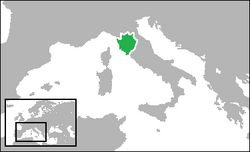Duchy of Florence
| Duchy of Florence | ||||||||||||
| Ducato di Firenze | ||||||||||||
|
||||||||||||
|
||||||||||||
|
The Duchy of Florence (green) in 1557
|
||||||||||||
| Capital |
Florence 43°47′N 11°15′E / 43.783°N 11.250°ECoordinates: 43°47′N 11°15′E / 43.783°N 11.250°E |
|||||||||||
| Languages | Italian | |||||||||||
| Government | Monarchy | |||||||||||
| Duke of Florence | ||||||||||||
| • | 1532–1537 | Alessandro | ||||||||||
| • | 1537–1569 | Cosimo I | ||||||||||
| History | ||||||||||||
| • | Established | 1532 | ||||||||||
| • | Battle of Marciano | 1554 | ||||||||||
| • | Elevated to Grand Duchy | 1569 | ||||||||||
| Currency | Florin | |||||||||||
|
||||||||||||
The Duchy of Florence (Italian: Ducato di Firenze) was an Italian principality that was centred on the city of Florence, in Tuscany, Italy. The duchy was founded after Emperor Charles V restored Medici rule to Florence in 1530. Pope Clement VII, himself a Medici, appointed his relative Alessandro de' Medici as Duke of the Florentine Republic, thereby transforming the Republic of Florence into a hereditary monarchy.
The second Duke, Cosimo I, established a strong Florentine navy and expanded his territory, purchasing Elba and conquering Siena. In 1569, the Pope declared Cosimo grand duke of Tuscany. The Medici ruled the Grand Duchy of Tuscany until 1737.
Florence had been under informal Medici control since 1434. During the War of the League of Cognac, the Florentines rebelled against the Medici, then represented by Ippolito de' Medici, and restored the freedom of their republic. Following the Republic's surrender in the Siege of Florence, Charles V, Holy Roman Emperor issued a proclamation explicitly stating that he and he alone could determine the government of Florence. On 12 August 1530, the Emperor created the Medici hereditary rulers (capo) of the Republic of Florence.
Pope Clement VII intended his relativeAlessandro de' Medici to be the ruler of Florence, but also wanted to give the impression that the Florentines had democratically chosen Alessandro as their ruler. The title "duke of Florence" was chosen because it would bolster Medici power in the region. In April 1532, the Pope convinced the Balía, Florence's ruling commission, to draw up a new constitution, which formally created a hereditary monarchy. It abolished the age-old signoria (elective government) and the office of gonfaloniere (titular head-of-state elected for a two month-term) and replaced it with three institutions:
...
Wikipedia



